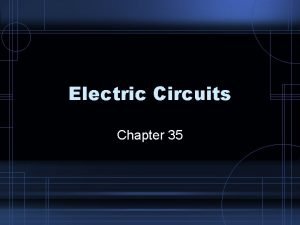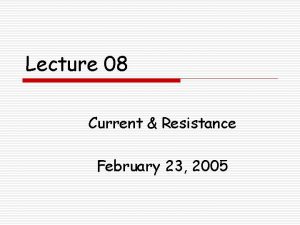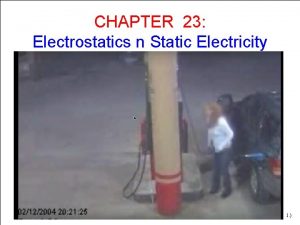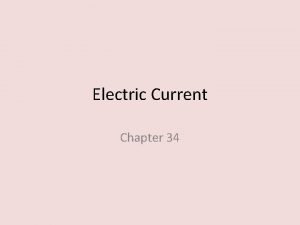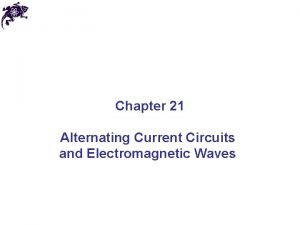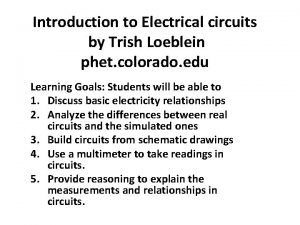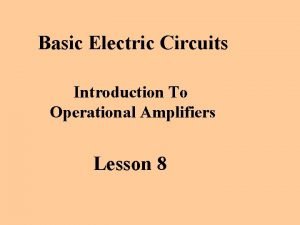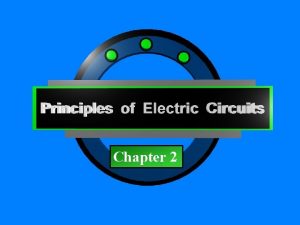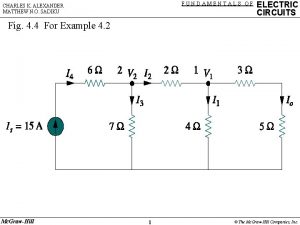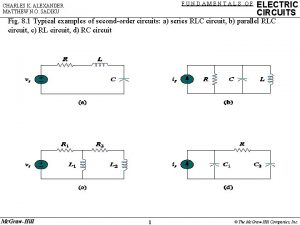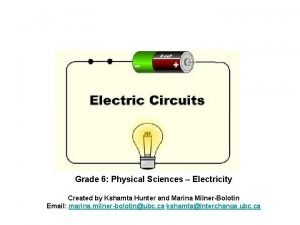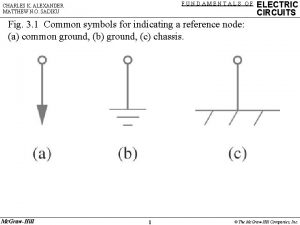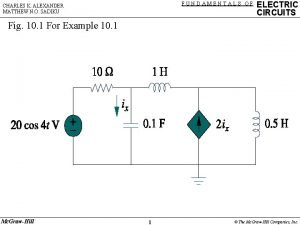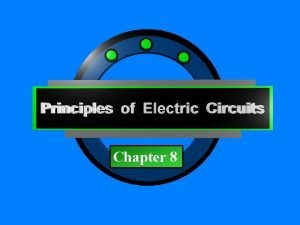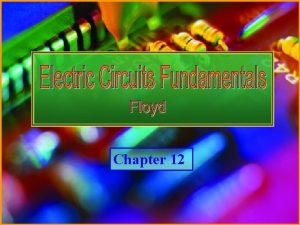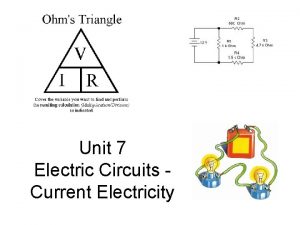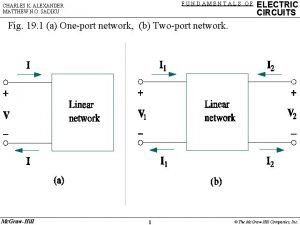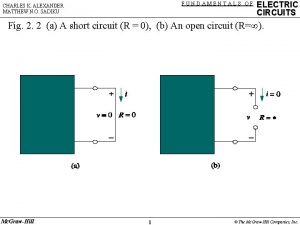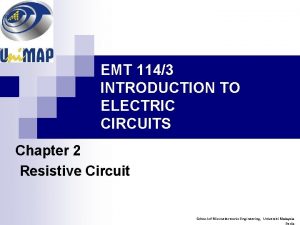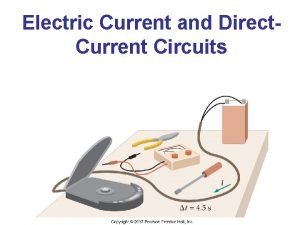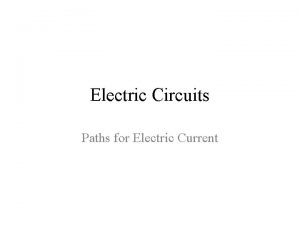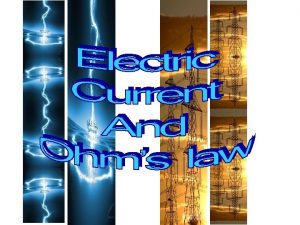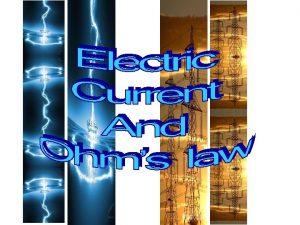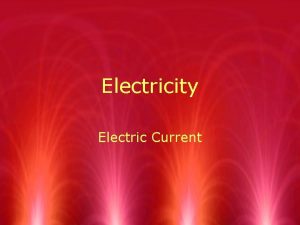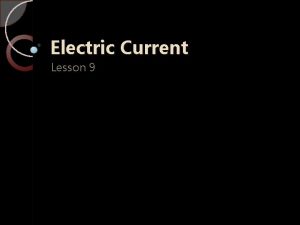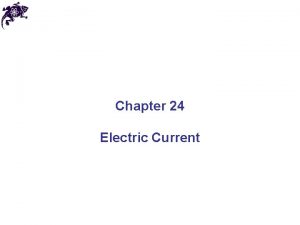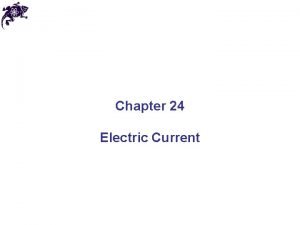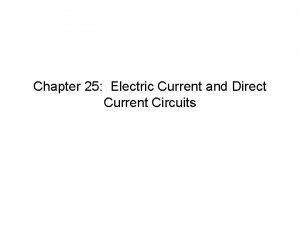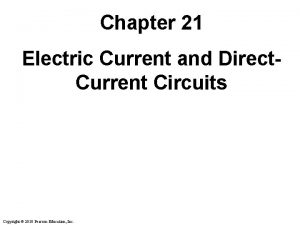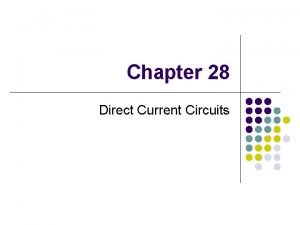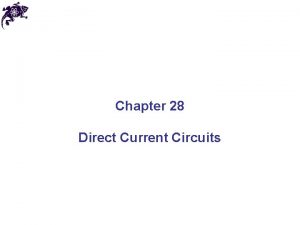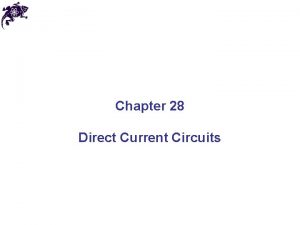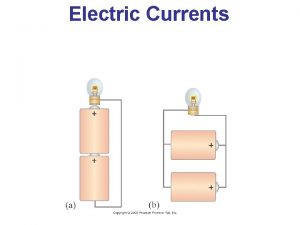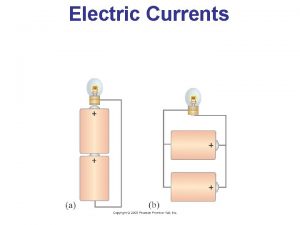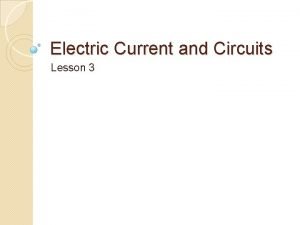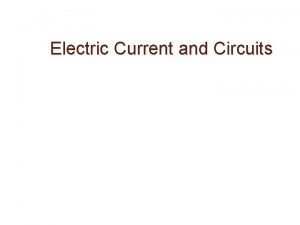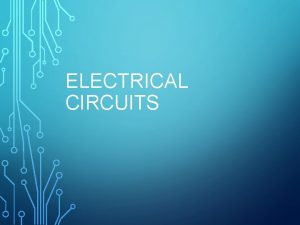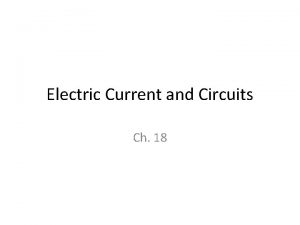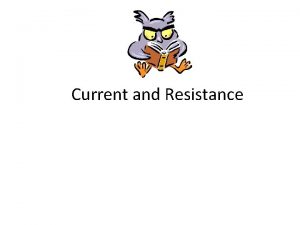Chapter 18 Direct Current Circuits Electric Circuits n


































- Slides: 34

Chapter 18 Direct Current Circuits

Electric Circuits n An electric circuit is a path through which charges can be conducted. n. A load is any element in a circuit that dissipates energy (eg battery, resistor, bulb). Wires have negligible resistance so we will not classify them as a load

Closed and Open Circuits n In a closed circuit there is a closed-loop path for electrons to follow. A closed circuit must be present for continuous current to exist. n In an open circuit there is not a complete path and therefore no charge flow nor current.

Sources of emf n The source that maintains the current in a closed circuit is called a source of emf (electromotive force) – Any devices that increase the potential energy of charges circulating in circuits are sources of emf – Examples include batteries and generators

emf and Internal Resistance A real battery has some internal resistance n Therefore, the terminal voltage is not equal to the emf n

More About Internal Resistance n n n The schematic shows the internal resistance, r The terminal voltage, ΔV = Vb-Va ΔV = ε – Ir IR = ε – Ir For the entire circuit, ε = IR + Ir

Resistors in Series n When two or more resistors are connected end-to-end, they are said to be in series n The current is the same in resistors because any charge that flows through one resistor flows through the other n The sum of the potential differences across the resistors is equal to the total potential difference across the combination

Resistors in Series, cont n Potentials add – ΔV = IR 1 + IR 2 = I (R 1+R 2) – Consequence of Conservation of Energy

Equivalent Resistance – Series n Req = R 1 + R 2 + R 3 + … n The equivalent resistance of a series combination of resistors is the algebraic sum of the individual resistances and is always greater than any of the individual resistance

Equivalent Resistance – Series An Example n Four resistors are replaced with their equivalent resistance

Ex. 1 n A 5 ohm, 10 ohm, and 15 ohm resistor are connected in series. A) Which resistor has the most current in it? B) Which resistor has the largest potential difference? C) What is the equivalent (or total) resistance of the circuit?

A 5 ohm, 10 ohm, and 15 ohm resistor are connected in series to a battery. Which resistor has the most current passing through it? 1. 2. 3. 4. 5 ohm 10 ohm 15 ohm All have the same current

A 5 ohm, 10 ohm, and 15 ohm resistor are connected in series to a battery. Which resistor has the largest potential difference across it? 1. 2. 3. 4. 5 ohm 10 ohm 15 ohm All have the same potential difference

When you add the potential differences across each resistor, what is the relationship to the total voltage? Individual voltages are greater 2. Individual voltages are all equivalent 3. Individual 1.

A 5 ohm, 10 ohm, and 15 ohm resistor are 1. 2. 3. 4. 5. connected in series to a battery. What is the equivalent resistance of the circuit? 5 ohms 10 ohms 15 ohms 30 ohms 40 ohms

Ex. 2 n Find the current and potential difference across each of the resistors in the following circuits: A) A 2 ohm and a 4 ohm resistor wired in series with a 12 V source B) A 4 ohm and a 12 ohm resistor wired in series with a 12 V source C) A 150 ohm and a 180 ohm resistor wired in series with a 12 V source

Resistors in Parallel n n Analogy: Students leaving an assembly –paths equal doors open, charges equal students The more doors that are open, the less the total resistance is The more doors that are present mean that less students pass through each door. The potential difference across each resistor is the same because each is connected directly across the battery terminals

Kirchoff’s Law n Kirchoff’s Law: The current, I, that enters a point must be equal to the total current leaving that point – I = I 1 + I 2 – The currents are generally not the same – Consequence of Conservation of Charge

Equivalent Resistance – Parallel, Examples Equivalent resistance replaces the two original resistances n Household circuits are wired so the electrical devices are connected in parallel n – Circuit breakers may be used in series with other circuit elements for safety purposes

Equivalent Resistance – Parallel n Equivalent Resistance ****The equivalent resistance is always less than the smallest resistor in the group

Ex. 3 n Find the current and potential difference across each of the resistors in the following circuits: A) A 2 ohm and a 4 ohm resistor wired in parallel with a 12 V source B) A 4 ohm and a 12 ohm resistor wired in parallel with a 12 V source

Ex. 4 n Find the equivalent resistance, the current in each resistor, and the current drawn by the circuit load for a 9. 0 V battery connected in parallel to the following resistors. n A) two 30 ohm resistors n B) three 30 ohm resistors n C) five 30 ohm resistors

Ex. 5 n Sketch as many different circuits as possible involving a battery and three bulbs of equal resistance. n How many different circuits would exist with four bulbs?

Problem-Solving Strategy, 3 n A complicated circuit consisting of several resistors and batteries can often be reduced to a simple circuit with only one resistor – Replace any resistors in series or in parallel using steps 1 or 2. – Sketch the new circuit after these changes have been made – Continue to replace any series or parallel combinations – Continue until one equivalent resistance is found

Problem-Solving Strategy, 4 n If the current in or the potential difference across a resistor in the complicated circuit is to be identified, start with the final circuit found in step 3 and gradually work back through the circuits – Use ΔV = I R and the procedures in steps 1 and 2

QUICK QUIZ 18. 3 With the switch in this circuit (figure a) open, there is no current in R 2. There is current in R 1 and this current is measured with the ammeter at the right side of the circuit. If the switch is closed (figure b), there is current in R 2. When the switch is closed, the reading on the ammeter (a) increases, (b) decreases, or (c) remains the same.

QUICK QUIZ 18. 3 ANSWER (a). When the switch is closed, resistors R 1 and R 2 are in parallel, so that the total circuit resistance is smaller than when the switch was open. As a result, the total current increases.

QUICK QUIZ 18. 4 You have a large supply of lightbulbs and a battery. You start with one lightbulb connected to the battery and notice its brightness. You then add one lightbulb at a time, each new bulb being added in parallel to the previous bulbs. As the lightbulbs are added, what happens (a) to the brightness of the bulbs? (b) to the current in the bulbs? (c) to the power delivered by the battery? (d) to the lifetime of the battery? (e) to the terminal voltage of the battery? Hint: Do not ignore the internal resistance of the battery.

QUICK QUIZ 18. 4 ANSWER (a) The brightness of the bulbs decreases (b) The current in the bulbs decreases (c) The power delivered by the battery increases (d) The lifetime of the battery decreases (e) The terminal voltage of the battery decreases

Equivalent Resistance – Complex Circuit

Electrical Safety n Electric shock can result in fatal burns n Electric shock can cause the muscles of vital organs (such as the heart) to malfunction n The degree of damage depends on – the magnitude of the current – the length of time it acts – the part of the body through which it passes

Effects of Various Currents n 5 m. A or less – can cause a sensation of shock – generally little or no damage n 10 m. A – hand muscles contract – may be unable to let go a of live wire n 100 m. A – if passes through the body for 1 second or less, can be fatal

Ground Wire Electrical equipment manufacturers use electrical cords that have a third wire, called a ground n Prevents shocks n

Ground Fault Circuit Interrupters (GFCI) n Special power outlets n Used in hazardous areas n Designed to protect people from electrical shock n Senses currents (of about 5 m. A or greater) leaking to ground n Shuts off the current when above this level
 Fundamentals of electric circuits chapter 4 solutions
Fundamentals of electric circuits chapter 4 solutions Chapter 20 electric circuits
Chapter 20 electric circuits Conceptual physics chapter 35
Conceptual physics chapter 35 Chapter 20 electric circuits
Chapter 20 electric circuits The circuit chapter 9
The circuit chapter 9 Fundamentals of electric circuits chapter 7 solutions
Fundamentals of electric circuits chapter 7 solutions Chapter 35 electric circuits answers
Chapter 35 electric circuits answers Chapter 35 electric circuits answers
Chapter 35 electric circuits answers Chapter 35 electric circuits
Chapter 35 electric circuits Chapter 23 electric current circuit happenings
Chapter 23 electric current circuit happenings Conceptual physics chapter 23 electric current
Conceptual physics chapter 23 electric current Chapter 34 electric current
Chapter 34 electric current Chapter 21 electric charge and electric field
Chapter 21 electric charge and electric field Chapter 21 electric charge and electric field
Chapter 21 electric charge and electric field Electric field k constant
Electric field k constant Units of a charge
Units of a charge What is a parallel circuit in physics
What is a parallel circuit in physics Alternating current circuits and electromagnetic waves
Alternating current circuits and electromagnetic waves Phet circuit
Phet circuit Electric circuits equations
Electric circuits equations James w nilsson
James w nilsson Principles of electric circuits
Principles of electric circuits What three elements are required for all electric circuits
What three elements are required for all electric circuits Fundamentals of electric circuits
Fundamentals of electric circuits Fundamentals of electric circuits
Fundamentals of electric circuits Elec 202
Elec 202 Electric circuits grade 6
Electric circuits grade 6 Charles k. alexander matthew n. o. sadiku
Charles k. alexander matthew n. o. sadiku Alexander
Alexander The circuit chapter 8 summary
The circuit chapter 8 summary Electric circuits fundamentals floyd
Electric circuits fundamentals floyd Circuit symbols
Circuit symbols Sadiku
Sadiku Fundamentals of electric circuits
Fundamentals of electric circuits Introduction to electric circuits
Introduction to electric circuits








